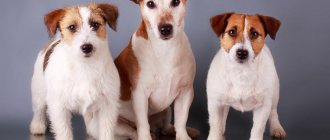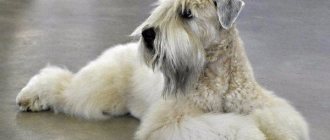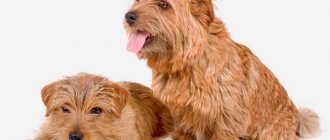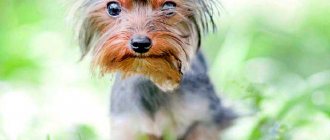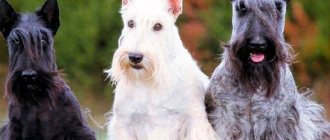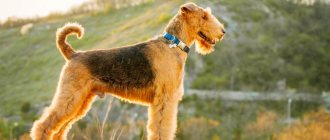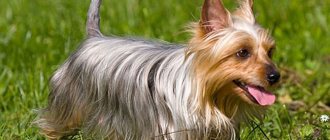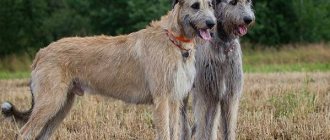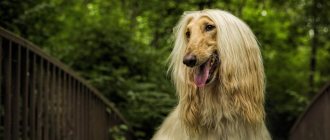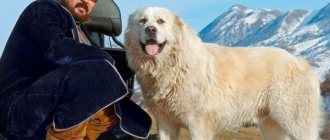The Irish Terrier is a born leader among dogs, capable of surprising its owner every day. In European countries it is called “sunny” because of its copper coat color, and in its homeland the dog received the nickname “devil” due to its fearlessness. The Irish Terrier has boundless courage, courage and hunting skills. Despite his stormy temperament and ability to make his own decisions, he becomes a true friend and loyal protector, capable of giving his life for the sake of his owner. From the article you will learn who this breed is suitable for and how to properly raise an obedient terrier.
brief information
- Country: Ireland.
- FCI class: Terriers (section No. 1 – large and medium terriers).
- Use: companion, hunting dog
- Color: Red.
- Life expectancy: 13-15 years.
- Average weight: Males up to 13 kg, females up to 12 kg.
- Height: 46-48 cm.
- Price: 20,000-40,000 rub.
Photo: needpix.com
Diet
Representatives of this breed are very unpretentious in food, but in order to avoid possible problems with the gastrointestinal tract, you need to carefully select the diet for them. When creating a menu, be guided by the following rules:
- food should be unsalted and low-fat;
- a couple of times a week you need to give your dog boneless fish (make minced fish fillets from small fish);
- the basis of the diet is veal, poultry, beef;
- it is important to add vegetables and herbs to your food, which are a natural source of vitamins;
- There should be no boiled cereals and soups in the diet;
- The recommended number of meals is 2 times a day, with most of the food being best given in the first half of the day;
- Every Irish dog should always have a bowl of clean, raw water available.
How to feed puppies correctly
It is important to provide terrier puppies with adequate nutrition until they are one year old, because during this period they are actively growing and developing physiologically. It is advisable to give children the most natural products possible: raw meat, sea fish, cereals, eggs, cottage cheese, raw vegetables and fruits. Under no circumstances should you feed your animal pork, spices, smoked or fatty foods . It is not recommended to include pies, bread, potatoes, and legumes in the menu.
An Irish puppy up to 5 months of age should be fed 4 times a day, up to 7 months - 3 times, by a year the frequency of feeding should be 2 times a day. You should not overfeed the animal, and any remaining food in the bowl must be removed before the next meal. You can give your baby ready-made food - canned food or dry food, but both products must be suitable for the dog’s age: for each age group, a certain composition is calculated, thanks to which the terrier’s body develops and forms correctly.
History of the origin of the breed
Today there is no documentary evidence of the origin of the breed. In Ireland, they believe that their terriers and wolfhounds appeared on the island even before the founding of the country, but official recognition of the breed occurred only in the middle of the 19th century.
The ancestor is believed to be the Welsh Terrier, brought from Britain to hunt rats and foxes. The first club for breeding Irish terriers appeared in Dublin in 1987, and it was its members who first began to talk about a ban on ear cropping in dogs of this breed. During the First World War they were used as messengers and trained to search for mines. The first Irish Terrier was brought to Russia after 1941 from Poland.
Health and Diseases of Irish Terriers
The Irish Terrier is a relatively healthy breed, and the “tail” of incurable genetic diseases does not follow it. However, dogs can suffer from hip dysplasia, hypothyroidism and von Willebrand-Diane disease. An unpleasant disease caused by heredity is hyperkeratosis of the paw pads. For some time, the breed disease did not manifest itself, which gave breeders hope for its complete disappearance. However, in recent years, individuals with pads “decorated” with callous and spine-like growths are increasingly being born. By the way, the disease is inherited in an autosomal recessive manner, which requires the presence of the hyperkeratosis gene in both parents.
Description of the breed
Externally, the red terrier is a medium-sized dog with an athletic build, the body is proportional. The wool is colored in a rich red shade and has increased rigidity. Dirt does not stick to it; with high-quality trimming, the water should roll off. On the muzzle there is decoration in the form of a fluffy mustache and beard, the hairs of which stick out in different directions.
The Irish Terrier is a versatile dog. With quality training, it becomes a companion, suitable for gun and hound hunting, and is an excellent watchman. Due to the large number of lean muscles, the pet develops enormous speed and is the fastest and most resilient among terriers. Has innate curiosity, high intelligence and the ability to make independent decisions.
Standard
The first official FCI standards were published in 1955. There are still no exact limits for height and weight for males and females. Even within the same litter, puppies can differ in size. Evaluation criteria for this breed:
- Frame. The Irish Terrier's body is medium-sized, proportionate and athletic. You can draw a straight line from above that smoothly transitions into the arched hips. Structural pathologies are rarely observed in puppies.
- Limbs. The front and hind legs are long and very springy. The muscles are clearly visible on them; powerful pulsating vessels appear on the outer side of the thighs after exercise. Large pads of black color, covered with wool on top.
- Head. The skull is long, of a typical dolichocephalic type. A narrow head with a sloping forehead should taper towards the nose. The nose is large and uniformly black. A pronounced mustache is formed on both sides of the nose, and a goatee is formed on the lower jaw. A healthy dog has large lips painted black, which looks quite comical when the muzzle is completely trimmed. The teeth are powerful but proportional. Forms a strong scissor bite. According to the standard, the ears should be folded into a triangle and lie parallel to the skull. The eyes are dark brown, the light iris is a defect of the breed.
- Wool. In adult dogs of medium length, very stiff. It is colored a rich red color; in puppies there is a black tint, which fades with age. A small white spot on the chest is allowed. The wool is pleasant to the touch, its texture resembles thick velor. Dirt and thorns do not stick to it. Regular trimming is required at least 2 times a year.
- Tail. Medium length, should be slightly rounded towards the end, twisting into a ring is a defect. There is a thickening at the base; cupping is today prohibited by European standards (used only for medical reasons).
Watching the Irish Terrier in the ring is a real pleasure. Representatives of this breed move smoothly, placing their front paws a long distance forward. During an individual examination, the correctness of the bite and the location of the testicles in male dogs are checked for compliance with the standard.
Photo: wikimedia.org
Relationships with a person
The Irish Terrier is distinguished by irrepressible energy, so if you hope that when you get a dog, you will calmly lie on the couch with it, then it is better to immediately discard the idea of buying such an animal. Athletes, tourists – people leading an active lifestyle – live comfortably with a dog of this breed. Thanks to their intelligence and endurance, the Irish will be useful to hunters. With proper training, dogs can even work for the police or rescue services .
Terriers are good with children. They can also get along with cats and dogs, but provided that the animals grew up together from early childhood. Otherwise, conflicts cannot be avoided, especially between individuals of the same sex. It is better not to let an Irish dog into a house where there are small pets or rodents, because the dog has very well developed hunting instincts.
Character and behavioral characteristics
When choosing an Irish Terrier as a pet, it is important to understand that the dog has a difficult character. This is a temperamental animal that always maintains a cheerful disposition and activity, but is subject to sudden mood swings. In Ireland they were nicknamed "the devil" because of their unique recklessness and lack of fear. An uncastrated male may rush at a larger and more powerful dog without assessing the consequences. All Irish Terriers are pugnacious and pick on other dogs and cats. This feature is manifested even in closely related mestizos.
The Irish Terrier adapts to being kept in an apartment; an aviary is not recommended for this breed. If you live in your own home, it is recommended to get a high fence - adult individuals can easily jump over high obstacles. The dog needs a lot of activity and physical activity. Running is the greatest pleasure for this breed. They easily follow a bicycle and reach speeds of up to 40 km/h in open areas. At the same time, the Irishman is extremely hardy; it takes several hours of active walks for the dog to begin to show fatigue.
Irish Terrier Personality
As a true native of the “land of leprechauns and red-haired bullies,” the Irish Terrier is quick-tempered, energetic and inexhaustible in all kinds of inventions. Fans of the breed claim that its representatives coexist with at least three canine personalities, each of which is the complete opposite of the others. In particular, in terms of work, Irish terriers are unparalleled hard workers, familiar first-hand with such concepts as responsibility and diligence. Guarding a house or searching for psychotropic substances, baiting a badger or running laps around a movie theater - the Irish Terrier takes on all of the above with pristine zeal and absolutely the same passion.
But as soon as the official tasks are finished, the dog’s behavior changes radically. The attentive worker and hunter immediately gives way to a mischievous clown and actor, whose “acts” sometimes cause laughter, and sometimes the desire to give the restless prankster a good kick. For example, Irish terriers are not only unsurpassed runners, but also incredible jumpers, so quietly stealing a cookie or sausage from the table is not only not a problem for the breed, but a most primitive trick. All kinds of latches and hooks for the “Irish” are fun puzzles that need to be sorted out as soon as possible. The end result of such a quest is usually the same: doors wide open and a pet disappearing in an unknown direction.
In their free time from work and play, red scoundrels prefer to mimic their environment, so if you don’t notice an Irish Terrier in the room, this does not mean that it is not there. Most likely, it has successfully blended into the interior and is lying imposingly in its corner. The Irish Terrier is a self-sufficient and proud breed, so don't expect your pet to need your approval before doing anything. On the other hand, these energetic athletes are strongly attached to the person they consider their master. Moreover, they are ready to completely adapt to the owner’s lifestyle, even if it does not always correspond to their natural inclinations. Do you like road trips? Your “Irish” will willingly lounge in the front seat and will enthusiastically stick its muzzle into the side window, catching the wind with its mouth. Do you prefer a healthier holiday? The red-haired smart guy won't refuse to go for a run and get a bicycle.
The Irish Terrier is forgiving towards children, provided that he has lived and been raised with them since puppyhood. No, he is not a trouble-free supernanny, but he is quite a good animator who knows how to support a game or a secret foray outside the apartment. In addition, he is able to withstand not the most gentle treatment from the baby, for example, a tug on his tail or an accidentally pressed paw. True, a dog will only restrain negativity if it is a one-time “bonus” and not systematic bullying. But, unfortunately, things don’t work out for the “Irish” with other four-legged dogs. Cats for them are target No. 1, subject to immediate destruction; dogs are potential rivals who need to be put in their place as often as possible. So finding a pleasant companion for the Irish Terrier among his fellow tribesmen is quite a task.
Education and training
When training and raising an Irish Terrier, one should take into account the peculiarities of its physiology and temperament. The dog does not tolerate aggressive methods towards itself; it is undesirable to use radical methods of training. Thanks to their innate intelligence, representatives of this breed master commands well, but it is important to be patient - the Irish Terrier often shows stubbornness. You need to approach classes wisely, combine rewards with food, emotions, and also use gaming methods.
Owners of Irish Terriers should prepare for the fact that their pet will require a lot of time for walks and regular exercise. With a passive lifestyle, the dog becomes sad, often more so, and may begin to gain excess weight. At least 3 walks per day with a total duration of 3-4 hours are recommended. Conduct active exercises at least once a week; running in an open area, group exercises, coursing - running after a mechanical hare - are better suited for this purpose.
When getting a puppy, you should be prepared for consistent and long-term upbringing. It is important to teach the Irish Terrier to remain calm and self-possessed in the face of irritating factors, and to obey the owner unquestioningly. Unlike shepherds, training for Irish terriers should be short and positive for the dog, otherwise the Irishman will become distracted and stubborn.
Key points in training
The breed is intelligent, but difficult to train. To raise a terrier, you need experience and special knowledge. A novice owner is unlikely to cope with the stubbornness and mistrust of the Irishman. You need to be a strict, tough leader, capable of alternating carrots and sticks. If the Terrier sees strength in its owner, then it will follow him.
But this does not mean that the dog should be beaten. The Irish cannot tolerate cruelty and will respond with aggression and anger. To punish a pet, it is enough to talk to it seriously, express your dissatisfaction, deprive it of toys, treats, or even food.
If you already have a puppy, but there are no training skills, then it is better to contact a breed club or city canine organization. There, teachers will select a program for the pet and its owner. During classes, the dog and the person will learn to interact and listen to each other.
It is important to teach the dog basic commands, learn its nickname, and the names of household members. In order for the dog to remember his name, it is important to call him more often and communicate with him. It’s the same with other words - the more practice, the better the result.
Read about how to properly train a dog in the article: “Training a puppy: effective methods from dog handlers, learning commands at home.”
Mating
It is recommended to breed an Irish Terrier no earlier than the second heat in order to avoid diseases of the reproductive organs in old age. The optimal age is 2 years, the mating itself is planned for 10-14 days. It is imperative to select a pair for this breed, since its representatives may differ in size. The male and female should be approximately equal in weight, height and size, this will avoid fetal death and caesarean section.
Conduct introductions only on the bitch’s territory, which is important to reduce anxiety, especially in young dogs. During mating, you must not scare the animals, make loud noises or invite strangers home. Control mating is usually carried out after 1-2 days. In large nurseries I practice artificial insemination, which is much more comfortable and painless for the animals.
How to choose a puppy
The choice of a baby is complicated by the fact that in Russia there are few nurseries that officially carry out breeding work. Usually a dog breeder can get a dog when he is 2-2.5 months old.
To choose the animal you like, it is better to get to know it at 1 month. During these visits, you should look at the mother’s reaction: if she tries to gather her heirs into a group and protect them, this is normal, but cowardice or aggression indicate mental abnormalities that can be passed on to the baby.
The dog breeder also needs to look at the reaction of the puppies: they should not try to run away, which may indicate poor socialization. A normal puppy should be sociable, respond well to affection, and strive to communicate. It is best to buy a future exhibitor at 5 months, when you can assess his exterior potential. The price of puppies is:
| Puppy cost | |
| Pets | From 20,000 rub. |
| Heirs of Champions | 30,000 – 40,000 rub. |
| No pedigree | 10,000 – 15,000 rub. |
Pregnancy
In the Irish, pregnancy normally lasts up to 56 days. Throughout gestation, reduce physical and emotional stress, which can cause the death of the entire litter. It is recommended to increase nutrition and the number of daily servings themselves, as well as give vitamin supplements. The litter size for this breed is 4-6 puppies; it is advisable to give birth only in a veterinary clinic.
Irish Terrier bitches have good maternal instincts, but the activity inherent in the breed is noted from the first months of life. Puppies are very playful and active, it is advisable to get a large cage for the whole family. Puppies can be adopted after 3-4 months and undergoing the necessary vaccinations.
Photo: wikimedia.org
Characteristics of who this dog is suitable for
When choosing a pet, you need to understand that the owner’s character type must match the dog. The Irishman is not capable of lying around for a long time and doing nothing, he needs to move. The Irish dog is suitable for people involved in sports. Also, the Irish Terrier is capable of staying in difficult, unusual conditions for months, which is why they are often recruited to serve in law enforcement or rescue companies.
For an avid hunter, such a partner will be indispensable; it will withstand any load.
Important! Love for people and a reverent attitude towards children is in the Irish blood. Any manifestation of aggression is practically impossible.
With proper upbringing, the dog will become the best friend for all family members.
Care
Despite its complex character, the Irish Terrier is easy to care for. The breed is suitable for living in a small apartment. Its huge advantage is that the animal does not shed; with regular plucking, the hairs practically do not remain on the surface of the furniture or the floor. Irish Terrier care rules:
- Frequent bathing is not recommended; there is practically no dirt left on the coat after walks;
- Trimming should be carried out at least 2 times a year; specialists carry out the procedure only with their fingers; the remaining hair can usually be removed with a pumice stone. The ideal situation is when a little old hair remains, but new ones are already beginning to grow - this creates volume and enhances texture;
- it is necessary to regularly check the ears and clean them of excess wax;
- claws need to be trimmed as they grow, and additional hair on the paws must be removed;
- After eating, owners recommend brushing the beard, otherwise food residue will end up on the furniture and the pet will begin to wipe itself off on its own.
The dog must have its own place in the apartment where it can sleep and relax. It is recommended to purchase a bowl with an adjustable height - the large length of the legs creates inconvenience when feeding from containers on the floor.
Photo: wikimedia.org
Learning ability
Irish owners agree that these dogs do not need training, in the usual sense of the word. They perceive any words spoken by a person, remember the sound and react accurately. Thus, a terrier can accurately find and bring a toy at the owner’s request: “bring a yellow rubber chicken” or “find a blue ball with pimples.”
A smart dog masters commands almost instantly - this is both a plus and a disadvantage. He gets bored with the monotonous program and constantly needs to change exercises. Instead of the methodical “sit and lie down,” the owner has to come up with a whole set of turns with subsequent shrinking. The only exception is excerpts. They need to be practiced strictly according to the methodology, forcing the dog to complete the task.
Forcing a proud Irish Terrier does not work. Any pressure kills his desire to obey. It is impossible to make a blind performer out of a dog. But with due patience and creativity, it will be possible to raise a pet that is ready to take responsibility for performing difficult work.
Owner reviews
Julia K. “We got an Irishman, this was our first dog. The biggest challenge with this breed is the need for exercise. We walk with Tru at least 4 hours a day, sometimes this is not enough. Despite his activity, he doesn’t chew the furniture at home and behaves with dignity.”
Victor M. “Fell in love with the Irish terrier at first sight. This is a very smart, hardy and active breed. I spend a lot of time outside with my pet and take him with me on bike rides. I came across the fact that Patrick constantly gets into fights, sometimes it’s difficult to stop him. Signed up for OKD, I hope it helps.”
References
- ^ a b c d
"Irish Terrier". wagwalking.com. Retrieved February 8, 2020. - ^ a b
"Irish Terrier". dogtime.com. Retrieved February 8, 2022. - ^ a b
Various authors (April 16, 2013).
Irish Terrier - The Complete Anthology of Dogs
. Reed Books LLC p. 123–. ISBN 978-1-4474-9178-1. - Breed Standard Irish Terrier Club of America
- "Ear training" Irish Terriers Stephanie
. - Pat I (1924–1941) Archived October 1, 2007 Wayback Machine Library and Archives Canada. Retrieved May 4, 2007
Advantages and disadvantages
Advantages of the breed:
- activity, curiosity and playfulness;
- pronounced intelligence, ability to learn;
- easy care, no shedding;
- beautiful exterior;
- possibility of training as a hunter, versatility.
Disadvantages include a short temper, physical demands, and emotional instability. The breed is not recommended for novice dog breeders.
Photo: pixabay.com
Distinctive character traits
The Irish have a strong nervous system, which is why they are used as gun dogs. Animals are very smart, learn quickly, remember a large number of commands and strictly follow the task assigned to them . Red terriers are not susceptible to motion sickness, unlike some other breeds. Breeders tried to breed the “ideal dog”, rejecting too aggressive and “nervous” Irishmen. As a result, the Irishman began to have the best character traits:
- courage;
- devotion;
- mind;
- poise;
- restraint;
- assertiveness;
- instant reaction;
- tirelessness;
- purposefulness.
Irish red dogs are known as “brave devils” due to their fearlessness, readiness to take off at any second to destroy the enemy. However, such a pet behaves well with its owner - it is affectionate and gentle, always ready for active games and fun. The advantages of the Irish also include their security and hunting qualities. The owners also note some disadvantages of their charges:
- pugnacity;
- vulnerability to mood swings;
- recklessness;
- assertiveness, irascibility.
- How to sow carrots so that they sprout in 3 days
- 5 Tips to Protect Yourself from Harmful Radiation from WiFi, Phones and Computers
- 6 innovations that will change the lives of motorists
Temperament
Representatives of the Irish dog breed are very active, kind and cheerful, and have a choleric temperament. Animals spend most of their time in motion, so long walks are an essential condition for the future owner of such a pet. Like other terriers, the Irish are smart, but stubborn and willful, so they have difficulty fulfilling the owner’s demands if they do not see their interest or special need in this.
When surrounded by other dogs, the Irish need to be closely monitored, because they love to bully and can be the first to provoke a conflict. For the same reason, it is better not to leave representatives of this breed alone with small pets - such a “meeting” can end badly - the Irish in most cases perceive them as a subject of hunting.
Terriers of Irish origin get along well with children, they are tireless in games, and have an excellent sense of humor. However, the child must be older - although the dog is friendly and non-aggressive, it will be extremely difficult for small children to resist the dog’s strength. At home, the pet behaves patiently and restrainedly: without the encouragement of the owner, he will not impose his presence on the household. Natives from Ireland perfectly convey all feelings - love, patience, sadness, while they are excellent companions, watchmen, hunters, bloodhounds and service dogs.
The cocky temperament of a representative of the Irish breed needs to be tamed from childhood, but it is not necessary to fully train the puppy. A dog intended to be kept in a city apartment must be taught at least minimal skills, which include prohibiting and calling commands. By devoting time to such training, a person will receive an obedient and faithful Irish friend.
Briefly about the main thing
- The Irish Terrier is a medium-sized, wire-haired dog. Brought out in Ireland, active distribution occurred in the 19th century.
- The physique is proportional and athletic. The fur is colored red, and there is a beard on the lower jaw.
- The terrier does not get along well with other dogs and cats. It is distinguished by pugnacity and lack of fear of danger.
- This is an intelligent and inquisitive animal that is easy to train. He is highly emotional and has a bright temperament.
- Care is not particularly difficult, but regular trimming is required. The breed is not recommended for beginners due to its stubbornness during training.
Health
The average life expectancy of an Irish Terrier is 14-15 years. If the owner carries out deworming, vaccination and treatment against skin parasites on time, the terrier will live for the maximum number of years.
It is important to visit the veterinary clinic with your pet annually. Such preventive examinations with x-ray examination will help to detect health problems in time and begin treatment.
The Irish Terrier is predisposed to the following diseases:
- Hypothyroidism is a disorder of the thyroid gland.
- Portosystemic shunt is an abnormal anastomosis between the portal system of the liver and the caudal vena cava, through which part of the blood, bypassing the liver, enters the general bloodstream.
- Myopathy is a disorder of the development of muscle tissue.
- Microphthalmos is a congenital malformation of the eye, in which one or both eyeballs are reduced in size.
- Cryptorchidism – one or both testes in male dogs have not descended from the abdominal cavity into the scrotum.
- Progressive retinal atrophy is an inherited disease that affects a terrier's ability to see.
- Cystinuria is a hereditary disease caused by a defect in the absorption of the amino acid cystine in the kidney tubules.
- Muscular dystrophy is a chronic disease characterized by progressive muscle degradation.
- Joint dysplasia – leads to severe impairment of the musculoskeletal function of the limbs.
- Von Willebrand disease - develops when there is a defective von Willebrand factor in the blood or its deficiency in the blood.
- Thrombopathy - insufficient blood clotting, occurs due to an abnormality of red blood cells.
Photo
Photo: flickr.com
Photo: flickr.com
Photo: wikimedia.org
Photo: wikimedia.org
Photo: wikimedia.org
Photo: wikimedia.org
Photo: wikimedia.org
Photo: pixabay.com
Photo: pixabay.com
Photo: pixabay.com
Photo: pexels.com
Color and coat type
The standard of a smooth-haired appearance implies the presence of a uniformly uniform red color. Only the ears can be darker and white markings on the chest are allowed.
If the same spots are present on the paws, the dog may be disqualified. Red fur can have different shades. A yellow-red palette is even acceptable.
It may have a color with a bright chestnut tint, like its fellow countryman, the Irish Setter. But all other colors as the main ones are strictly rejected.
The dog's fur should feel like thin copper wire to the touch. The hairs are somewhat broken, but not curly. The forelimbs, jaws and sides of the neck are distinguished by longer hair.
In other places it grows densely and is straight and short. This difference creates the effect of swiftness and the overall expressiveness of the silhouette.
Feeding
An important issue in caring for a dog is nutrition. Here, for sure, what you put in is what you get. If you skimp on feeding your dog, you will end up with health problems for that very dog. And the money you save will be taken to the nearest veterinary hospital. And it’s not a fact that you won’t have to shell out much more money there than you spent on quality food
You can feed your Irish Terrier the same as any other dog.
If you decide to feed your pet dry food, then there is no problem; the only thing you need to do is pay attention to the quality of the food. Good food is labeled “premium” or “super-premium”
You should not buy other types of food; feeding such food can seriously harm your pet. Remember that if you decide to feed your dog dry food, the dog must have constant access to water at all times. The dog should always have water. The second option is feeding natural food.
If you decide to choose this feeding option, you should definitely consult with a specialist about what additives should be added to this food. The nutrients contained in regular food are not enough for the normal development of a dog. Well, it's time to draw conclusions.
So, the Irish Terrier is an excellent family dog. If you are looking for a loyal friend, companion and playmate, then the Irish Terrier is an excellent choice. If you are interested in this breed of dog, then find a photo of the Irish Terrier
you can on our website or anywhere else on the World Wide Web. Actually, that's all, come see us again.
Advantages and disadvantages
Icelandic Shepherds are excellent family dogs with virtually no faults. They are incredibly loyal and so attached to a person that they always try to be as close to him as possible. True, sometimes they can get in the way and get under your feet.
The desire to please and high intellectual abilities allow the Icelandic dog to learn quickly and remember everything well. And her activity and mobility often make her a champion in various types of dog sports.
But such an energetic dog requires long daily walks. Therefore, it is not suitable for sedentary people, or as a sofa pet.
These are very cheerful and cheerful dogs who love to frolic and play. Often other pets also participate in these games, on which, even during entertainment, the Icelandic Shepherd shows its herding instinct, not allowing them to leave the territory and trying to keep everyone in one place. The same applies to children, with whom such a pet has a wonderful relationship.
The Icelandic Sheepdog does not forget about protecting its territory. She will always notify you of the arrival of guests, and in some cases she will be able to bravely protect the owners from uninvited strangers. Although the dog treats strangers with some distrust, when he sees the joy on the owner’s face, he immediately becomes peaceful and affectionate.
These dogs are very dependent on human communication and have difficulty withstanding loneliness. And some breeders even recommend trying to give such a pet as much attention as possible until the age of eighteen months, gradually teaching it to be left alone.
Icelandic Shepherds are affectionate and loving. They know how not only to receive, but are also ready to give all their tenderness in return and become a faithful companion for their human family.
Nutrition for puppy and adult dog
There are several basic rules when feeding any dog: do not give fatty, sweet or smoked foods, and also try to avoid baked goods.
Proper nutrition consists of meat products (chicken, beef, turkey), sea fish, cereals and vegetables. It is useful to include eggs and dairy products in your puppy’s diet, but only without preservatives, additives and sugar. You need to feed your puppy three to five times a day, depending on its age. For an adult dog, two meals a day is enough.
To make it convenient for your pet to eat, use a stand, preferably one that can be adjusted in height, since the bowls should be at the same level as the chest. 20 minutes after feeding, remove the food bowl, even if the dog has not finished eating. And the second bowl should always be filled with clean water.
